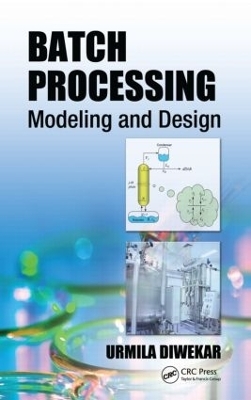
Batch Processing
Modeling and Design
Seiten
2014
Crc Press Inc (Verlag)
978-1-4398-6119-6 (ISBN)
Crc Press Inc (Verlag)
978-1-4398-6119-6 (ISBN)
Although batch processing has existed for a long time, designing these processes and unit operations has been considered an onerous task that required computational efforts. Design of these processes is made more complex because of the time dependent nature of the process and the allowable flexibility. More often than not, every unit encounters optimal control problems. Therefore, traditional design books have not covered batch processing in detail. Filling this void, Batch Processing: Modeling and Design describes various unit operations in batch and bio-processing as well as design methods for these units.
Topics include:
Batch distillation operating modes and configurations
Batch absorption operations based on the solubility difference
Batch adsorption based on differential affinity of various soluble molecules to solid absorbents
Batch chromatography for measuring a wide variety of thermodynamic, kinetic, and physico-chemical properties
Batch crystallization where a phase is used to find the supersaturation at which point material crystallizes
Batch drying that stresses the phase diagram of water to describe this operation
Batch filtration using a porous medium or screen to separate solids from liquids
Batch centrifugation where centrifugal force is used for separation
Batch processes are widely used in pharmaceutical, food, and specialty chemicals where high value, low volume products are manufactured. Recent developments in bio-based manufacturing also favor batch processes because feed variations can be easily handled in batch processes. Further, the emerging area of nanomaterials manufacturing currently uses batch processes as they are low volume, high energy intensive processes. With examples, case studies, and more than 100 homework problems, this book describes the unit operations in batch and bioprocessing and gives students a thorough grounding in the numerical methods necessary to solve these design problems.
Topics include:
Batch distillation operating modes and configurations
Batch absorption operations based on the solubility difference
Batch adsorption based on differential affinity of various soluble molecules to solid absorbents
Batch chromatography for measuring a wide variety of thermodynamic, kinetic, and physico-chemical properties
Batch crystallization where a phase is used to find the supersaturation at which point material crystallizes
Batch drying that stresses the phase diagram of water to describe this operation
Batch filtration using a porous medium or screen to separate solids from liquids
Batch centrifugation where centrifugal force is used for separation
Batch processes are widely used in pharmaceutical, food, and specialty chemicals where high value, low volume products are manufactured. Recent developments in bio-based manufacturing also favor batch processes because feed variations can be easily handled in batch processes. Further, the emerging area of nanomaterials manufacturing currently uses batch processes as they are low volume, high energy intensive processes. With examples, case studies, and more than 100 homework problems, this book describes the unit operations in batch and bioprocessing and gives students a thorough grounding in the numerical methods necessary to solve these design problems.
Urmila Diwekar
Introduction. Numerical Methods for Integration. Batch Reactors. Batch Distillation. Optimization and Optimal Control. Batch Absorption. Batch Extraction. Batch Adsorption. Batch Chromatography. Batch Crystallization. Batch Drying. Batch Filtration. Batch Centrifugation. Batch Scheduling and Planning. Batch Process Simulation.
| Zusatzinfo | 28 Tables, black and white; 99 Illustrations, black and white |
|---|---|
| Verlagsort | Bosa Roca |
| Sprache | englisch |
| Maße | 156 x 234 mm |
| Gewicht | 498 g |
| Themenwelt | Medizin / Pharmazie ► Pflege |
| Naturwissenschaften ► Biologie | |
| Naturwissenschaften ► Chemie ► Technische Chemie | |
| Technik ► Umwelttechnik / Biotechnologie | |
| ISBN-10 | 1-4398-6119-6 / 1439861196 |
| ISBN-13 | 978-1-4398-6119-6 / 9781439861196 |
| Zustand | Neuware |
| Haben Sie eine Frage zum Produkt? |
Mehr entdecken
aus dem Bereich
aus dem Bereich
Grundlagen, technische Anwendungen, Rohstoffe, Analytik und …
Buch | Softcover (2023)
Springer Vieweg (Verlag)
CHF 55,95
erneuerbare Energien und Speichertechnologien für die Energiewende
Buch | Softcover (2023)
De Gruyter Oldenbourg (Verlag)
CHF 97,90
Daten, Formeln, Normen, vergleichende Betrachtungen
Buch | Softcover (2024)
Europa-Lehrmittel (Verlag)
CHF 54,45


